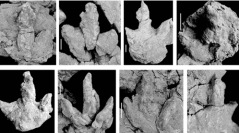

 Comptes Rendus Palevol
11 (4) - Pages 231-239
Comptes Rendus Palevol
11 (4) - Pages 231-239Along the southern crystalline border of the Rouergue, the detrital Sandstones-variegated Mudstones Formation and the Dolomitic Formation yields numerous dinosaur footprints from the Earliest Hettangian. Among the 25 sites distributed along the 40 km-long transect between Marcillac-Vallon and Saint-Geniez-d’Olt, two of them, Puech de Castres and Le Bouyssou, have yielded abundant ichnites in various well-defined stratigraphic units. The combined analysis of these footprints with biometric and morphometric methods (Fourier analysis) warrants their identification to Grallator, Eubrontes and Dilophosauripus. The dual methodological approach also reveals two new morphotypes previously unknown in the Causses Basin. Moreover, the footprints assigned to Grallator and Eubrontes tend to be morphologically similar, suggesting that they might correspond to a same taxon of Coelophysoidea theropod at different growth stages. This dinosaur fauna was living in a vast floodplain, in which fluvial channels carried southward the detrital material coming from the Rouergue substratum. The Dolomitic Formation was deposited in the context of a northward marine transgression during which shallow and aerial environments prevailed in the area.
Rodez Strait, Lower Hettangien, Fourier analysis, Floodplain, Dinosauroid footprints, Theropoda, France